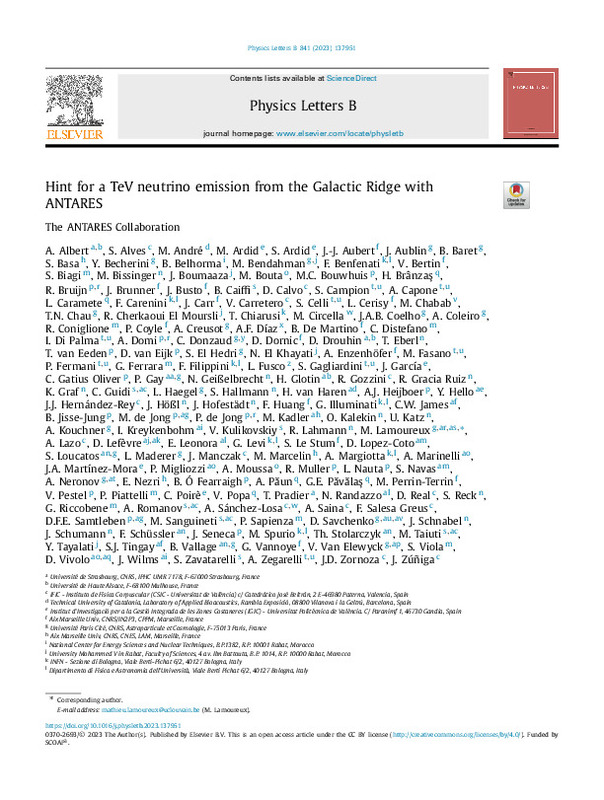|
Resumen:
|
[EN] Interactions of cosmic ray protons, atomic nuclei, and electrons in the interstellar medium in the inner part of the Milky Way produce gamma-ray flux from the Galactic Ridge. If the gamma-ray emission is dominated by ...[+]
[EN] Interactions of cosmic ray protons, atomic nuclei, and electrons in the interstellar medium in the inner part of the Milky Way produce gamma-ray flux from the Galactic Ridge. If the gamma-ray emission is dominated by proton and nuclei interactions, a neutrino flux comparable to the gamma-ray flux is expected from the same sky region.
Data collected by the ANTARES neutrino telescope are used to constrain the neutrino flux from the Galactic Ridge in the 1-100 TeV energy range. Neutrino events reconstructed both as tracks and showers are considered in the analysis and the selection is optimized for the search of an excess in the region |l| < 30 degrees, |b| < 2 degrees. The expected background in the search region is estimated using an off-zone region with similar sky coverage. Neutrino signal originating from a power-law spectrum with spectral index ranging from Gamma nu = 1to 4is simulated in both channels. The observed energy distributions are fitted to constrain the neutrino emission from the Ridge.
The energy distributions in the signal region are inconsistent with the background expectation at similar to 96% confidence level. The mild excess over the background is consistent with a neutrino flux with a power law with a spectral index 2.45(-0.34)(+0.22) and a flux normalization dN nu/dE nu= 4.0(-2.0)(+2.7) x 10(-16) GeV-1 cm(-2) s(-1) sr(-1) at 40 TeV reference energy. Such flux is consistent with the expected neutrino signal if the bulk of the observed gamma-ray flux from the Galactic Ridge originates from interactions of cosmic ray protons and nuclei with a power-law spectrum extending well into the PeV energy range.
[-]
|
|
Código del Proyecto:
|
info:eu-repo/grantAgreement/AEI/Plan Estatal de Investigación Científica y Técnica y de Innovación 2021-2023/PID2021-124591NB-C41/ES/ELESCOPIOS DE NEUTRINOS PARA FISICA FUNDAMENTAL Y ASTRONOMIA MULTIMENSAJERO EN EL IFIC/
...[+]
info:eu-repo/grantAgreement/AEI/Plan Estatal de Investigación Científica y Técnica y de Innovación 2021-2023/PID2021-124591NB-C41/ES/ELESCOPIOS DE NEUTRINOS PARA FISICA FUNDAMENTAL Y ASTRONOMIA MULTIMENSAJERO EN EL IFIC/
info:eu-repo/grantAgreement/AEI/Plan Estatal de Investigación Científica y Técnica y de Innovación 2021-2023/PID2021-124591NB-C42/ES/TELESCOPIOS DE NEUTRINOS PARA FISICA FUNDAMENTAL Y ASTRONOMIA MULTI-MENSAJERO EN LA UPV/
info:eu-repo/grantAgreement/AEI/Plan Estatal de Investigación Científica y Técnica y de Innovación 2021-2023/PID2021-124591NB-C43/ES/TELESCOPIOS DE NEUTRINOS PARA FISICA FUNDAMENTAL Y ASTRONOMIA MULTI-MENSAJERO EN LA UGR/
info:eu-repo/grantAgreement/ANR//ANR-10-LABX-0023/FR/Universe: observation, modeling, transfer/
info:eu-repo/grantAgreement/ANR//ANR-18-IDEX-0001/FR/Université de Paris/
info:eu-repo/grantAgreement/EC/H2020/101025085/EU/Unifying Neutrino Observatories Searches/
info:eu-repo/grantAgreement/EC/H2020/754496/EU/FELLowship for Innovation at INFN/
info:eu-repo/grantAgreement/GENERALITAT VALENCIANA//CIDEGENT%2F2019%2F043//AYUDA CONTRATACION CIDEGENT INVESTIGADORES DE EXCELENCIA-ARDID RAMIREZ, JOAN/
info:eu-repo/grantAgreement/GV INNOV.UNI.CIENCIA//ASFAE%2F2022%2F014//Telescopios submarinos de neutrinos: nuevas perspectivas /
info:eu-repo/grantAgreement/Junta de Andalucía//P18-FR-5057/
info:eu-repo/grantAgreement/GVA//PROMETEO%2F2020%2F019/
info:eu-repo/grantAgreement/GVA//CIDEGENT%2F2018%2F034 /
info:eu-repo/grantAgreement/GVA//CIDEGENT%2F2020%2F049 /
info:eu-repo/grantAgreement/GVA//CIDEGENT%2F2021%2F23/
info:eu-repo/grantAgreement/MICINN//ASFAE%2F2022%2F023/
info:eu-repo/grantAgreement/MICINN//ASFAE%2F2022%2F014/
[-]
|
|
Agradecimientos:
|
The authors acknowledge the financial support of the funding agencies: Centre National de la Recherche Scientifique (CNRS), Commissariat a l'Energie Atomique et aux Energies Alternatives (CEA), Commission Europeenne (FEDER ...[+]
The authors acknowledge the financial support of the funding agencies: Centre National de la Recherche Scientifique (CNRS), Commissariat a l'Energie Atomique et aux Energies Alternatives (CEA), Commission Europeenne (FEDER fund and Marie Curie Program), Labex UnivEarthS (ANR-10-LABX-0023 and ANR-18-IDEX-0001), Region Alsace (contrat CPER), Region Provence-Alpes-Cpte d'Azur, Departement du Var and Ville de La Seyne-sur-Mer, France; Bundesministerium fuer Bildung und Forschung (BMBF), Germany; Istituto Nazionale di Fisica Nucleare (INFN), the European Union's Horizon 2020 research and innovation programme under the Marie Sklodowska-Curie grant agreement No 754496, Italy; Nederlandse Organisatie voor Wetenschappelijk Onderzoek (NWO), the Netherlands; Executive Unit for Financing Higher Education, Research, Development and Innovation (UEFISCDI), Romania; Grants PID2021-124591NB-C41,-C42,-C43 funded by MCIN/AEI/10.13039/501100011033 and, as appropriate, by "ERDF A way of making Europe", by the "European Union" or by the "European Union NextGenerationEU/PRTR", Programa de Planes Complementarios I+D+I (refs. ASFAE/2022/023, ASFAE/2022/014), Programa Prometeo (PROMETEO/2020/019) and GenT (refs. CIDE-GENT/2018/034,/2019/043,/2020/049./2021/23) of the Generalitat Valenciana, Junta de Andalucia (ref. P18-FR-5057), EU: MSC program (ref. 101025085), Programa Maria Zambrano (Spanish Ministry of Universities, funded by the European Union, NextGenerationEU), Spain; Ministry of Higher Education, Scientific Research and Training, Morocco, and the Arab Fund for Economic and Social Development, Kuwait. We also acknowledge the technical support of Ifremer, AIM and Foselev Marine for the sea operation and the CC-IN2P3 for the computing facilities.
[-]
|









